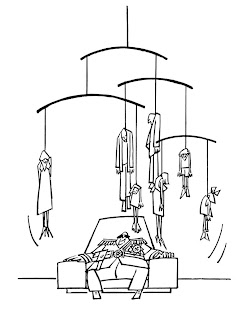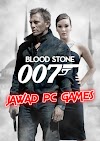At the beginning of this presentation, I would like to first quote what Pierre Franzot judiciously wrote in the French magazine Caricature et Caricaturistes in 1989:
“Although the person we are introducing to you today draws political and current-events cartoons as well as comic strips, what makes him a true master is his superior approach to the graphic arts and the humor. With trepidation I take off my hat to a great artist who is completely unknown in France. It is my hope that our own talented youth will be influenced by him.
The power of this Near Eastern artist’s pen is such as to cause envy among many of his Western colleagues and he is fully entitled to such praise but rather than face charge of “laying it on with a trowel” I will withdraw and leave you alone with his drawings. In order to appreciate his work, you needn’t know that his father was a military officer or what schools he studied in. It will suffice if you know this: Since the very beginning, Turhan has been a cartoonist who has transcended all the rules and labels. Like Chaval, he too has a singular, individual style – one that cannot be classified or pigeonholed. Influenced by the post-war cartoons and humor of Steinberg, Turhan developed, on his own, simultaneously creating a unique personal style and established a world of his own. In order to understand the force of his humor, it is sometimes necessary to dwell upon the sparseness of his aesthetics. For Turhan, a pen is a mean of expression. Turhan Selçuk is one of the most consistently surprising humorists of our days.”
 Tuhran published his first cartoon album in 1954. Although the here above book is his seventh cartoon album, Turhan’s bibliography was already much longer, as 36 yearly books of his comic strips character Adbdülcanbaz were published at that time (1989).
Tuhran published his first cartoon album in 1954. Although the here above book is his seventh cartoon album, Turhan’s bibliography was already much longer, as 36 yearly books of his comic strips character Adbdülcanbaz were published at that time (1989).

In the same year, Tuhran said in an interview: "In a country like ours, where one loves so much humor, one gets too much angry with humor too... Many lawsuits are brought against cartoons or puns taken too seriously. I think it is because there is no tolerance in Turkey that prevails in the West. Turkish people take humor more seriously, give it more importance. In short, we can state that « Turkey humor is serious business » and I think that's one of the peculiarities of Turkish humor."From Republic presidents to heads of political parties, many people filed a lawsuit against me. Most of the time I was acquitted; once or twice, I was sentenced.
 Tuhran also said: ”Few weeks after the 12 March 1971 military coup, I was arrested and detained. At the riot police barracks I was beaten, I had fractured ribs when there were no legal charges about me. Yes indeed, as I said: In my country humor is serious business. We may add: and sometimes it is also dangerous.”
Tuhran also said: ”Few weeks after the 12 March 1971 military coup, I was arrested and detained. At the riot police barracks I was beaten, I had fractured ribs when there were no legal charges about me. Yes indeed, as I said: In my country humor is serious business. We may add: and sometimes it is also dangerous.”“The Professional Organization of French Newspapers Cartoonists in Paris has protested the arrest of Mr. Selçuk, Turhan Selçuk who is the most famous of Turkish cartoonists. Works of his have been published in many foreign countries. He is cited in Enciclopedia dell’ Humorismo; he has achieved fame for his cartoons, his original graphic style, and his sharp wit.”
Le Monde / 1971 (France).

Here are some cartoons from this book published in 1995 :




In the same year, the Turlisk magazine Gül_Diken published a special issue entirely dedicated to Turan Selçuk and his work. In 152 pages all in English, this monograph is quite detailed: excellent articles with cartoons and photos, bio & bibliography.

In 2003, to celebrate Tuhran’s gold jubilee (60 years career!), Cumhuriet published a big book: 300 (large) pages with many many cartoons and some photos too.





The first personal exhibition of Turhan works took place at Istanbul in 1951. All long his life many other exhibitions were presented. The art critic of the New York Herald Tribune wrote in 1956: “The aim of contemporary humor is not to be funny. Italians critics place the works of Turkish cartoonists among the best examples of the modern approach to humor. Turhan Selçuk is a Turkish artist and a cartoon of his on display at this exhibition is one of the finest examples of this approach. In this cartoon, a skin-diver who is spear-fishing under the water is taking aim at a duck swimming on the surface. Imagine how surprised the duck would be if it were to shot in this way: it is just this surprise that is the humorous element of this cartoon.”
In 1962, the Turkish author and journalist Abdi İpekçi wrote: “Turhan Selçuk has courageously embraced the modern approach to cartooning. No one thought he would be able to overcome the facile market mentality that prevailed in Turkey; no one believed he would be able to gain appreciation for “graphic humor”. But he did. He applied all the innovations that modern approach to cartooning demanded of drawing, subject, and style and achieved great popularity and recognition.”

The eminent cartoon historian and Italian cartoonist Gec [Enrico Gianeri] wrote in 1970: “The beauty and grace that imbue the drawings of Turhan Selçuk, the most famous of Turkish cartoonists, are perhaps not to be found in the work of any other cartoonist in the world. The combination of the mystic lines of the Orient with a satirical content that is thoroughly modern gives his work an international flavor. This is why Turhan Selçuk’s cartoons do not need to be captioned and why, indeed, some of them seem to look at us as if to say “Why don’t you get rid of this caption and let us take care of ourselves?” It’s as if they’re speaking Esperanto. Just as the movies of Lyda Borelli and the Collo Capozzi Alberti brothers need no sound, so too are the cartoons of Turhan Selçuk in no need of writing in order to look at them. The revolution that Turhan Selçuk has wrought has made him the Bakunin of Turkish cartooning, to which he has given a new direction. He has altered the direction given to Turkish art by Cem, Rıkfı, and Sedat Nuri, breaking the bonds of tradition, renewing it, and forcing it into the contemporary mainstream. The modernization that was rather timidly attempted by the well-known cartoonist Ramiz was brought off and perfected by Turhan. With him, there opened up a new artery – a new mode of expression. Imagine a style of cartooning whose power of synthesis is at the level of Olaf Gulbransson but which leaves a flavor reminiscent of Japan’s Hokusai and you will have the cartoons of Turhan Selçuk.”

In 1992, his 50th jubilee was celebrated by an exhibition in Istanbul. The same year an exhibition of his works entitled “Human Rights” toured several major European cities (at the Council of Europe in Strasburg and Izmir first); then Nurnberg, Dortmund, Duisburg, Stuttgart, Manheim, Munich.


In 1993 the exhibition was shown in Paris and Leipzig,



Shot at Paris, from left to right: French cartoonists: Mofrey, Solo, Gus, and Turhan.
In 1994 the exhibition travelled to Rotterdam, Skopje and Nicosia, then to Frankfurt and continued to other countries, up to South Africa in 1997.

At the end of this article, I wish to express all cartoonists and the Turkish people my sincere condolences.
J-M Bertin.
Learn more:
Cartoonbook files and links(click to enlarge):
http://www.sanalmuze.org/sergiler/contentxy.php?sergi=397&ic=90&pg=0













0 Comments